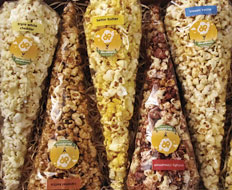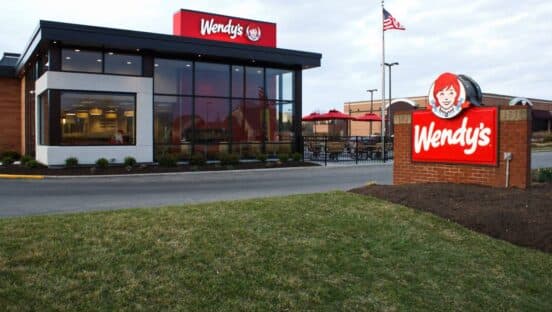Robert Israel says the first time he tasted kettle corn, he “freaked out.”
“I was a New Yorker,” he says. “I came to visit my sister in Colorado and had kettle corn at the Boulder County Farmer’s Market. I had never had it before and was totally blown away.”
Israel, who previously ran a clothing company, went back to New York and began figuring out a way to make kettle corn as healthy and natural a snack as possible. He also worked with equipment manufacturers to come up with self-venting electric kettles, so he could make the snack indoors.
“No one was making popcorn indoors because you can’t safely use propane indoors, so we had to be creative,” Israel says.
Israel also got creative with flavors, coming up with eight choices in addition to the traditional sweet and salty kettle corn varieties. The popcorn is made with corn oil and all flavors have between 60–80 calories per cup, are low in fat, and have no trans fat or cholesterol.
The result was the December 2003 opening of the first Doc Popcorn location in the FlatIron Crossing Mall in Broomfield, Colorado, the closest indoor mall to Boulder.
“Trends were slowly moving toward better-for-you snacks,” Israel says. “So the timing was good for bringing a healthier snack to a high-traffic location.”
The timing was also good for finding real estate.
“We opened up our first Doc Popcorn in a failed cookie store and were immediately successful,” he says. “Our model in malls has been to take over space from other challenged food concepts. We help people who are stuck on leases they don’t want to be stuck on and bring the mall a new concept.”
Israel says that while selling a natural, healthy product is important to him, he knew that for Doc Popcorn to be successful, the product had to be both “indulgent and delicious,” and operating systems had to be simple.
“A lot of concepts spent too much on stores and made processes too complicated,” he says. “We have one piece of equipment that produces all of our flavors. We don’t need venting, and some of our locations don’t even need water; we can bring in a portable sink.”
Most flavors are put in the kettle to melt or pop with the heat of the popper. A few get additional seasoning after popping.
The menu at Doc Popcorn is simple. There are two sizes—small and large—and nine varieties of popcorn: Triple White Cheddar, Better Butter, Caramel Kettle, Klassic Kettle, Sweet Butter, Cheesy Cheddar, Sinfully Cinnamon, Hoppin’ Jalapeño, and Salt-n-Pepper. Beverage choices consist of all-natural soft drinks from Blue Sky Soda and Oogavé.
When it comes to business models, the Doc Popcorn concept gets a bit more complicated. There are four to choose from: a stand-alone kiosk, an in-line mall space, a mobile unit, and a catering unit.
Israel says the in-line stores can be created in what is otherwise dead space in a mall.
Doc Popcorn
President: Robert Israel
HQ: Boulder, Colorado
Year Started: 2003
Annual Sales: Undisclosed
Total Units: 24
Franchise Units: 13
“We can convert space like an underutilized seating area into an income-generating space,” he says.
At in-line stores, a small 3-ounce popcorn is $3.50 and a large 5-ounce is $4. Prices are slightly higher at mobile venues, but Israel says bags are over-filled at all venues to give customers a value. Doc Popcorn also sells gift packs of popcorn online and at its in-line stores, which is about 5 percent of sales annually but jumps to 20 percent during the holidays.
The mobile units pare down the menu to three choices to make ordering less confusing. Only Cheesy Cheddar, Klassic Kettle, and Sweet Butter are offered in mobile units to make customer lines move faster. The branded mobile units, he says, work well at farmer’s markets, sporting events, air shows, rodeos, concerts, and other outdoor events.
The fourth model is a catering unit branded with the Doc Popcorn logo. It is a table that breaks down small enough to fit in a car and works at venues where a cart is too large, like corporate events, weddings, and parties.
Franchising is also offered at different levels with Doc Popcorn. There’s the single level, which includes one unit; the standard level, which includes three units; and the “empire building” level, which includes 10 Doc Popcorn units.
“The variety of business models makes Doc Popcorn attractive to a variety of potential franchisees,” Israel says.
He says a lot of people are struggling in today’s economy, and through Doc Popcorn he can offer franchisees independence and financial freedom.
“Now things are really ramping up,” he says. “And we are not limited by geography because of the simplicity of our operations. We’re ready to roll out nationwide.”
Doc Popcorn already has locations in Arizona, California, Colorado, Georgia, Indiana, Michigan, Minnesota, Tennessee, and Texas, and Israel says he would like to see at least 100 Doc Popcorn locations open in 2011 and 300–500 in the next five years.
“I think the sky is the limit,” he says. “But my real goal is to have really satisfied franchisees.”









